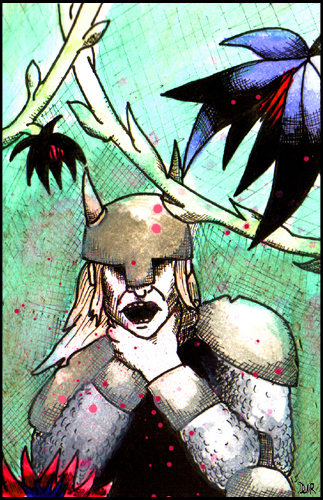Instead of a classically defined monster, I thought I would use this installment of Monsters of the Hyborian Age to look at one of the obstacles Conan faces in Queen of the Black Coast and what is probably one of the most iconic species of flora in Howard’s writing – the black lotus (plus a bonus lotus). In keeping with the way the black lotus is used in the story, I think the best way to represent the plant is as a fantastic terrain feature (I could have gone with a natural hazard trap, but there didn’t seem to be enough mechanical meat to the black lotus to justify this).
As far as I can tell three other types of mystical lotus plant are mentioned in the chronicles of Conan (the purple, yellow and golden lotus – which makes the lotus a bit like the Hyborian equivalent of kryptonite), but only the black and purple varieties are suitable for D&D fantastic terrain. The juice of the golden lotus and dried yellow lotus incense are better used in-game as magic items. When Monsters of the Hyborian Age is finished, I would love to do a post with a few of the magic items Conan encountered during his adventures.
For the summary of Queen of the Black Coast, as well as the Winged One monster, click here.
Spoiler Alert! All of these Hyborian age posts are going to be filled with spoilers. From the summary, to the monster stats they are going to ruin any surprises as to what the monster is, when it appears in the story and how and why it is killed. You’ve been warned.
Fantastic Terrain
“He recoiled, recognizing the black lotus, whose juice was death, and whose scent brought dream-haunted slumber. But already he felt a subtle lethargy stealing over him.” – Robert E. Howard, Queen of the Black Coast.
The lustrous, heavy flowers of the black lotus cling to rocks and other vegetation and can be combined with any other mundane terrain feature. Any creature that ends its turn on or adjacent to a square of black lotus inhales the sinister plant’s narcotic pollen and is slowed (save ends). Creatures that fail their first saving throw become unconscious (save or the target takes damage ends). Unconscious creatures receive strange, disturbing dreams that are often prescient or retro-cognitive concerning the area the black lotus grows.
Creatures immune to poison or who do not breathe are unaffected by the pollen of the black lotus.
Purple Lotus
“Tsotha displayed a broad ring of curious design from his finger. He pressed his fingers together and on the inner side of the ring a tiny steel fang darted out like a snake’s tongue.
‘It is steeped in the juice of the purple lotus which grows in the ghost-haunted swamps of southern Stygia,’ said the magician. ‘Its touch produces temporary paralysis…” – Robert E. Howard, The Scarlet Citadel.
Clumps of purple lotus can grow in any wet or swampy location. The juice of the plant’s sap is a powerful paralytic, which makes weapon play dangerous in their midst. A creature in a square with purple lotus that takes physical damage from an attack is immobilized (save ends). Creatures that fail their first saving throw become paralyzed (save ends).
Creatures immune to poison are unaffected by the sap of the purple lotus.
Notes
“Hey… black lotus… Stygian… the best!”
I couldn’t resist.
This took me a little longer than expected (maybe I should have used some of that black lotus). I am determined to have an illustration for each Monsters of the Hyborian Age entry, but truth be told I was just not that motivated to make a picture of a flower. In the end I came up with a composition that didn’t bore me to tears, and I’m pretty happy with the visualization of the lotus’ spores, but I really hate what I did with the background…
Tags: 4e, Conan, D&D, Original Art
